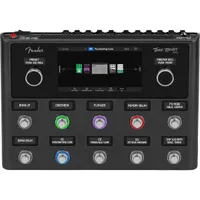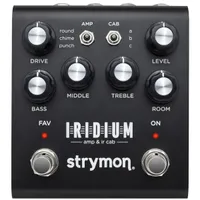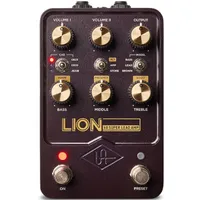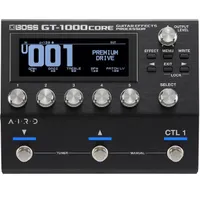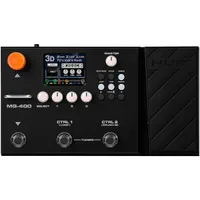Best amp modelers 2025: Get your dream guitar tone with my top picks
Amp models so good, you’ll think they’re the real thing

The best amp modelers can sound and feel as good as traditional guitar amplifiers whilst offering additional flexibility, transportability and, for many, additional creativity. Don’t get us wrong, there’s still a time and place for a cranked 75-watt tube amp, but for the gigging, session, or budget-conscious guitarist, the versatility of amp modelers is hard to beat.
I've been using an amp modeler as part of my own rig for the last three years now, and I can't honestly see myself doing without one nowadays. Between myself and the Guitar Player team, we've tested loads of amp modelers in the real world, taking them to shows, on tour, in the studio, or just messing around at home with them.
If you're looking for the best amp modeler overall, there's no question for me that it's the Neural DSP Quad Cortex. Jam packed full of quality tones and loads of options for signal routing, it's actually surprisingly easy to use considering just how much depth it has. If the QC is a little pricey for you though, have a look at the Hotone Ampero II Stomp, which delivers insane value for money.
If you're new to amp modelers, then you'll want to check out my FAQs section, which answers loads of common questions around amp modelers. We've also got a glossary of key terms if you're struggling with any of the very tech-y lingo you'll find in this guide.
My top picks

Packed with amp models that are as close to the real thing as you can get, the Neural DSP Quad Cortex makes complex signal chains effortless, rightfully earning its place at the top.
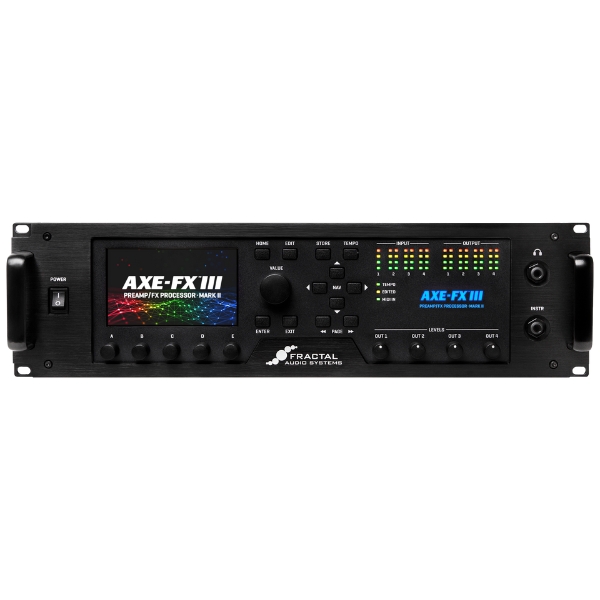
Having been one of the top choices for live players for years, the Fractal Axe-FX III combines excellent processing power with relentless reliability, making it perfect for touring guitarists.
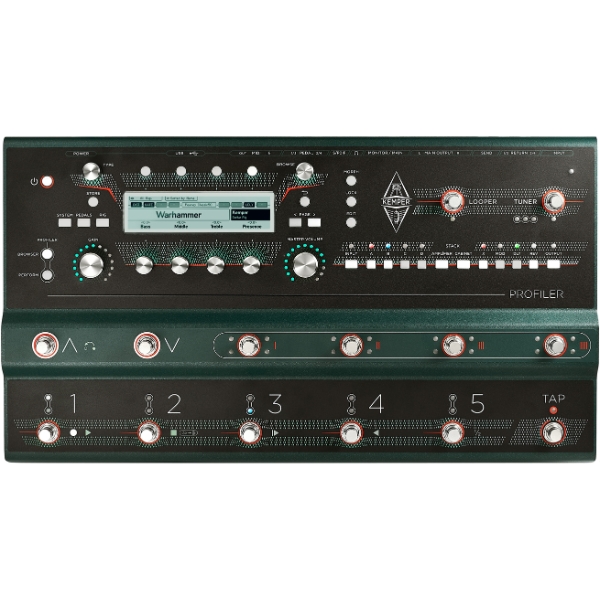
Despite being one of the older models on this list, the Kemper Profiler Stage is still unmatched as a profiler, allowing you to accurately and easily capture the sound of your real guitar amp.

Amp modeling can get expensive quickly, but the Line 6 Helix LT offers excellent value for money coming in just below the $1,000 and offering just as much as more expensive models.

If you want a compact option to create a hybrid setup with an amp and mount on your pedalboard, the Headrush Core is easy to travel with, and you can plug a microphone into it too.
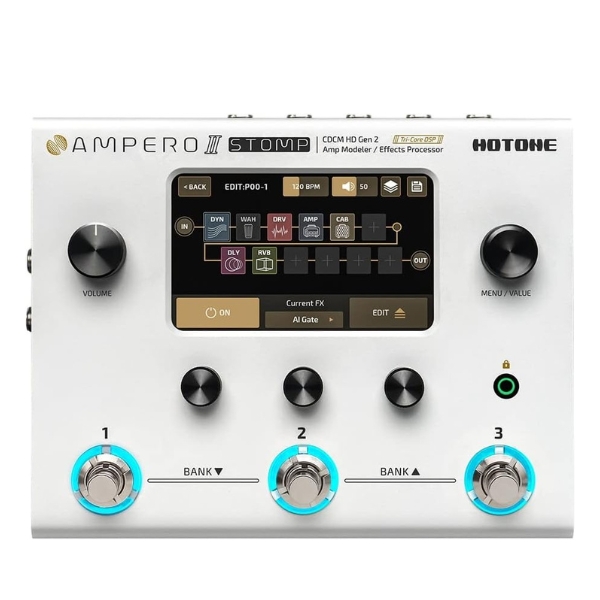
If you want an amp modeler on a tight budget, the Hotone Ampero II Stomp gets our vote. It sounds phenomenal and is nice and compact too, making it great for beginners.
Best overall

Specifications
Reasons to buy
Reasons to avoid
✅ Buy if you want an easy-to-use yet complete amp modeler: Despite its myriad features and depth of tweaking available, I love how easy to use the QC is thanks to its large touch screen and clever footswitches that double as endless encoders.
❌ Avoid if you want to use Neural plugins: We're still waiting for support for the vast majority of Neural's excellent plugins to make their way over to the QC, so if you want to use your plugins on the hardware you might be waiting a while.
Even after the hype from its launch in 2020 has had time to die down, Neural DSP’s Quad Cortex is still the modeler to beat. With sounds so close to the real thing, countless musicians have traded their tube amplifiers in to use the QC full time.
With class-leading processing power courtesy of its SHARC quad-core processor, the Quad Cortex suffers from zero latency, regardless of how advanced the user wants to go with complex internal effects chains to complement their captured amplifier.
And complex effects chains are where the Quad Cortex stands above rivals, as its intuitive interface allows even total novices to fairly quickly get their head around the system and create everything from natural tube-amp tones to cinematic, stereo soundscapes. Managing these complex chains is also remarkably simple, thanks to the graphical signal-chain displayed and edited via the inbuilt LCD touch-screen, which is a particular highlight.
Whilst those looking to be a bit ‘different’ may be deterred by the fanfare over the Quad Cortex, it does come with the benefit of a vast community of users who have created their own amp presets on the ‘Cortex Cloud’. All the plaudits are accurate – this is the best amp modeler you can buy right now.

"From any angle, the Quad Cortex is a clever, feature-packed, well-built, and great-sounding unit. What’s more, it’s truly fun and inspiring to play and easy to use. It promises to be a strong contender in this market, and earns an Editors’ Pick Award for its achievement."
Read more: Neural DSP Quad Cortex review
Best for live performance
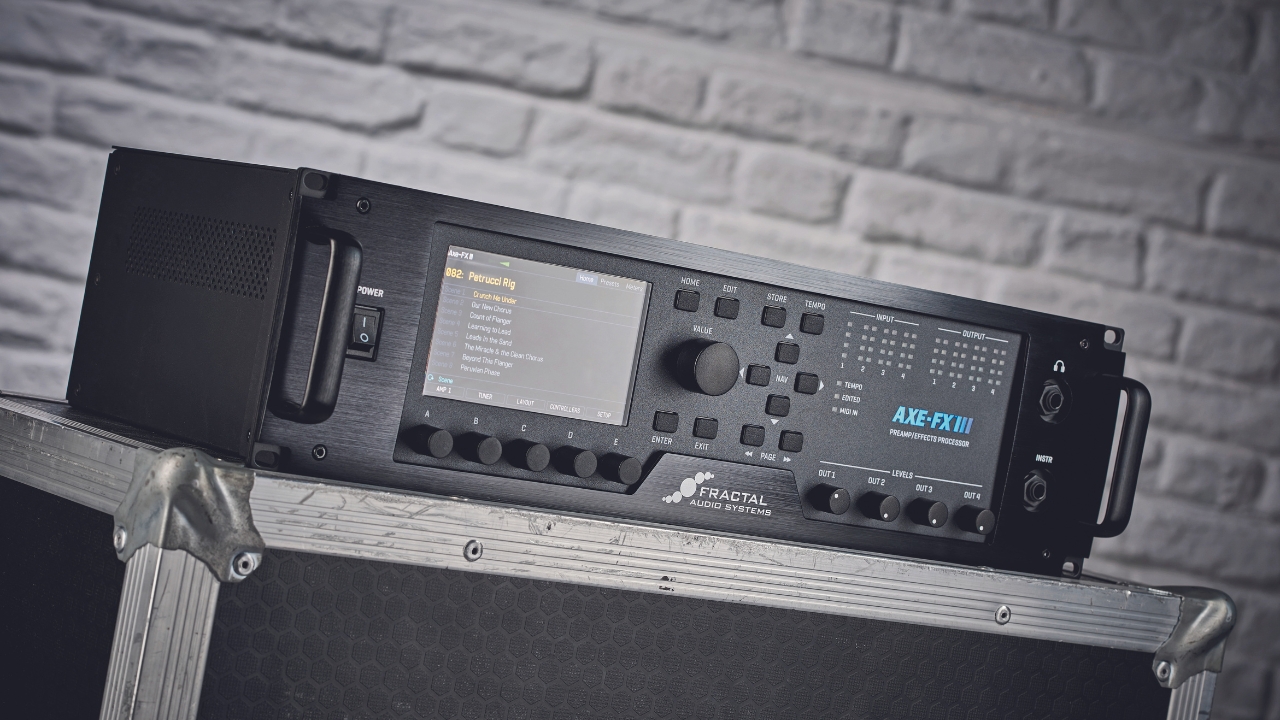
2. Fractal Axe-FX III Mark II Turbo
Our expert review:
Specifications
Reasons to buy
Reasons to avoid
✅ Buy if you want to regularly play live: A staple of touring pros the world over, the Axe-FX is designed for regular live use on the road with excellent durability and a superb range of amp and effects tones.
❌ Avoid if you only play at home: If you're exclusively playing at home, then the Axe-FX is likely to be overkill for your needs and you'll likely get more out of a different, simpler unit.
Unlike rivals from Kemper and Neural, which sit firmly in the same price bracket, Axe-Fx III Mark II is a genuine amp modeler, rather than a profiler, so its amps are created without the cue of a hardware amplifier.
This doesn’t mean the Axe-Fx sounds worse though, and the rack-mounted version of the unit has been among the top choices for live players for years, due to its supreme reliability, immense processing power and spellbinding in-built effects – which can be programmed to be controlled by MIDI, to seamlessly engage during a set.
The Mark II Turbo version comes equipped with a 25% clock speed boost that allows players to go even more complex with their effects chains, whilst the addition of extra flash memory makes it future-proofed for updates.
The sonic capabilities of the Axe-Fx system are remarkable and its ability to react to playing dynamics makes it feel just like a real amplifier – the real barometer for tube amp aficionados. It also reacts with external pedals well, so for people who don’t necessarily want to move both amp and effects over to a modeler, the Axe-Fx III will be great with your existing pedalboard.
The big downside to the Axe-Fx remains the fact that Fractal still only sells directly/through singular select dealers per territory, which isn’t ideal if you want to go to your music store to A/B test against rivals.
Best profiler
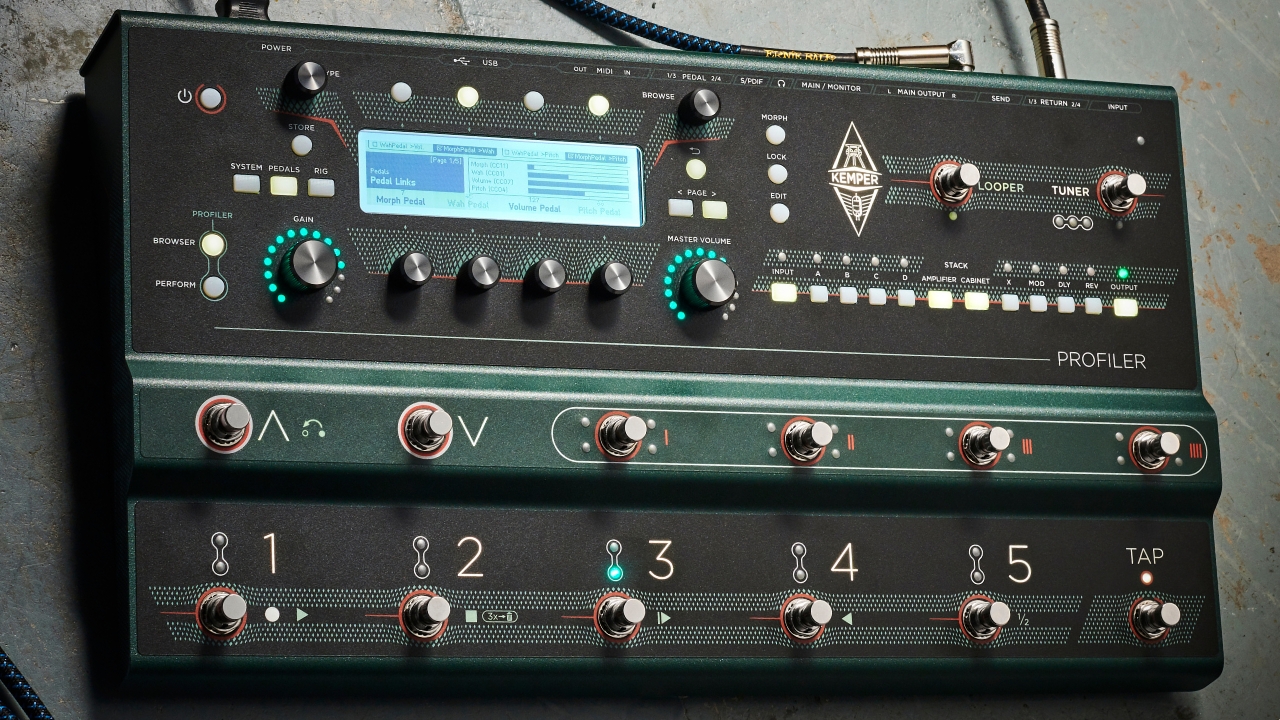
3. Kemper Profiler Stage
Our expert review:
Specifications
Reasons to buy
Reasons to avoid
✅ Buy if you want a huge selection of amps: Being a profiler the Kemper features a massive array of accurately profiled guitar amp tones, making it a top pick if you want the biggest variety of amp tones.
❌ Avoid if you want ease of use: Due to its age, the Kemper Profiler Stage definitely feels a little behind the competition when it comes to its user interface.
The legacy pick and still among the best. Whilst some of the Kemper hardware is starting to feel its age, the company does still release software updates that keep its hardware firmly within the grasp of its contemporaries in the area that matters most; the amp sounds.
Despite its age, the Kemper Profiler Stage still sounds brilliant and the ability to ‘digitally clone’ any vintage amplifier you like through its profiling technology remains Kemper’s biggest selling point. Where it has lost some ground on rivals is its ease of use, which isn’t totally effortless during set-up, though in a performance situation, it is far more intuitive and natural for guitarists.
For those looking for a modeler to go straight on the road with, Kemper’s build quality has become legendary and is perfect for professional gigging musicians, who rely on the reliability of their equipment, even after being thrown about.
Its Floorboard Profiler Stage is our pick of the range due to its portability and sleek design, however we’d recommend checking out Kemper’s powered heads if you require a modeler with an integrated power amp.
Best under $1,000
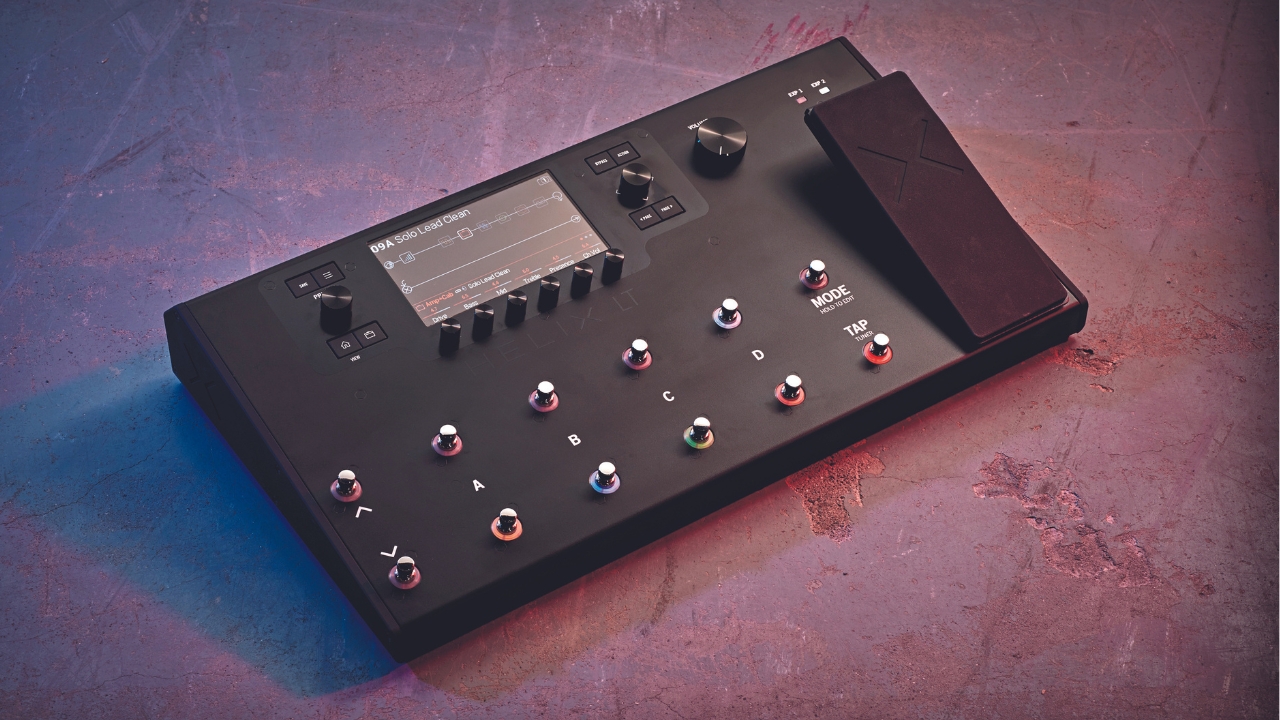
4. Line 6 Helix LT
Our expert review:
Specifications
Reasons to buy
Reasons to avoid
✅ Buy if you want great value for money: Jam packed with amp and effects models and being consistently updated, the Helix LT is superb value for money below the $1k mark, giving you everything you need for home and live use.
❌ Avoid if you want quick tones: I've found the Helix LT needs tweaking or external IRs to sound its best, so be prepared to experiment with settings to get the best out of it.
Line 6 was among the first players in guitar modeling, back when other manufacturers laughed at the idea that people would trade in their amps for modelers… with the success they’ve experienced with their Helix range, Line 6 definitely had the last laugh.
The Helix LT is Line 6’s stripped back, ‘budget-friendly’ version of its full Helix floorboard modeler. For us, it’s the pick of its extensive range and ideal for players looking to get a gig-worthy modeler, without breaking the $1000 barrier… just.
Can it compare to the likes of Fender and Neural’s offerings? Yes, just about. In comparison everything feels that little bit clunkier, and the amp models aren’t quite as refined – though there are regular software and firmware updates by Line 6 to improve these, which is commendable after all the years the Helix range has been in production. Its LCD screen is bright and easy to see, though the lack of touchscreen is noticeable compared to rivals.
What has to be considered with the Helix LT though, is that it undercuts its illustrious competition by a significant amount, with the quality remaining high. If you’re looking for a modeler for the live environment and can’t stretch past $1000, this is the best amp modeler on the market at that price point.
Best compact
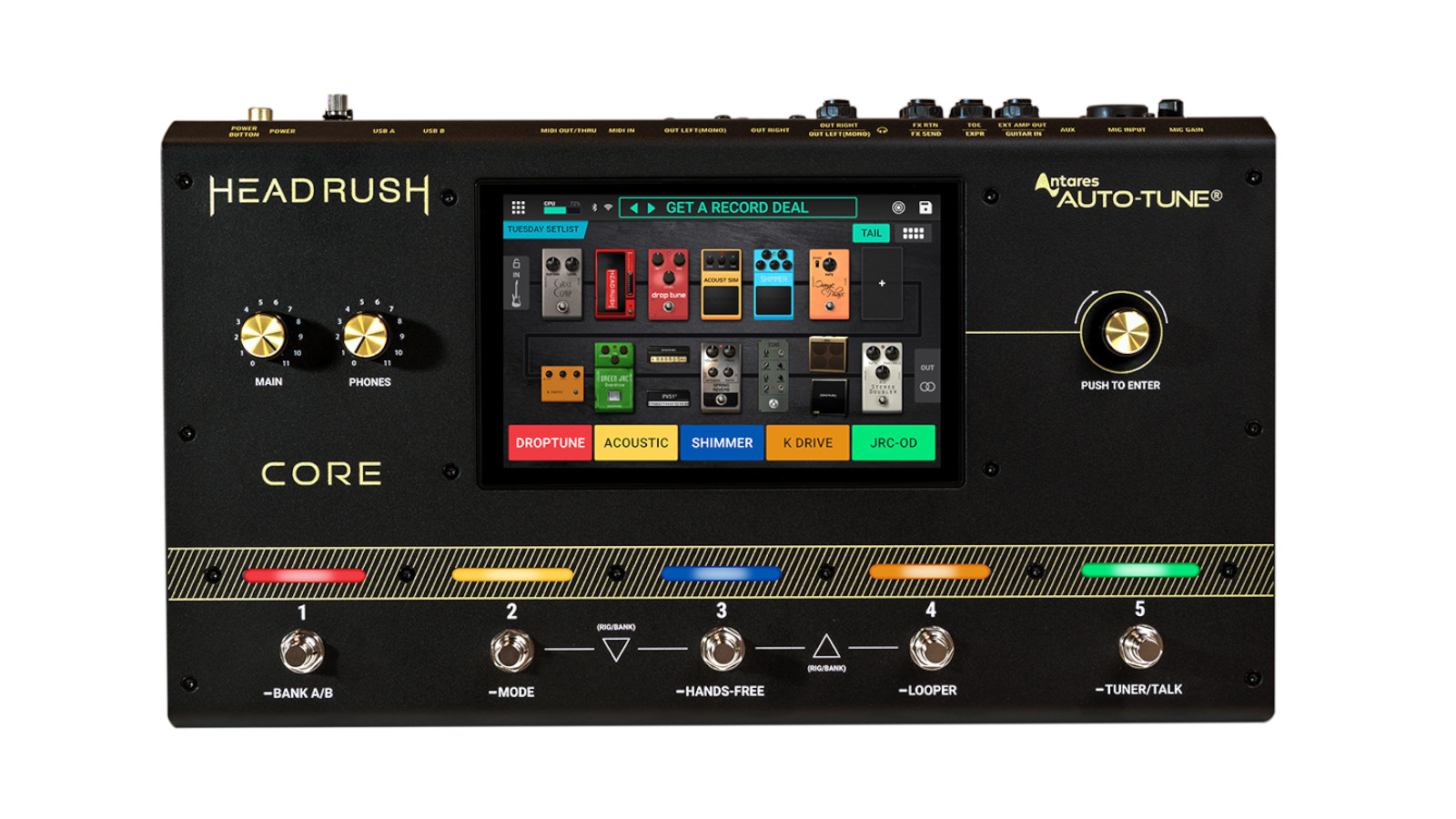
5. Headrush Core
Our expert review:
Specifications
Reasons to buy
Reasons to avoid
✅ Buy if you want compact amp modeling: Its compact form factor and light weight makes the HeadRush a great option for traveling to shows, or just using at home where space is at a premium.
❌ Avoid if you need more features: With no expression pedal and lack of footswitches, there are places who will find the HeadRush Core a little too limiting for their particular needs.
The Headrush Core is ideal for anybody looking for a compact modeler for the live environment, particularly for those who want control over their vocals too, with the standout feature of the Headrush Core being its in-built vocal processing, including Antares Autotune. This makes it a superb live tool for those who want full control over their vocal sound as well as their guitar tones.
The intuitive touch screen makes both vocal and guitar manipulation effortless in use and the overall simplicity and user-friendliness of the Headrush Core is among its biggest selling points. And it doesn’t stop there with its tricks; it also has the ability to ‘clone’ an amp with Headrush’s unique amp cloning feature – which is equally intuitive in use as the rest of the Core – meaning there are potentially infinite tonal options.
Some may be tempted to pay the little bit extra to go for the Core’s big brother – the Headrush Prime – however the size and weight reduction in the Core (at around half the weight of the Prime) can’t go unnoticed, and that could be a real plus point for those who want something compact and easy to travel with. It also has the same digital signal processor as the Prime, the same software, and it happens to be significantly cheaper – which makes it our pick of the two.
Best budget

6. Hotone Ampero II Stomp
Our expert review:
Specifications
Reasons to buy
Reasons to avoid
✅ Buy if you're on a budget: Amp modelers are expensive, so if you're on a tight budget the Ampero II Stomp gives you a lot for less than $500.
❌ Avoid if you need more features: Like the HeadRus Core this is a smaller unit, which means less footswitches and features overall.
The Ampero II Stomp is powered by the catchy ‘Advanced CDCM HD (Comprehensive Dynamic Circuit Modeling High Definition)’ and ‘F.I.R.E. (Field Impulse Response Enhancement)’ systems, which use dynamic feature modeling where independent amp ‘components’ are rebuilt digitally to create very accurate models.
You'd be forgiven for thinking that this sounds like a lot of marketing nonsense, but in practice the Ampero II Stomp backs up the acronyms with superb and varied amp models, which feel and sound organic and natural.
Hotone has also upped its components from the initial Ampero lineup, with the Stomp II coming loaded with additional processing power, better AD/DA conversion, improved dynamic range, and upgrades in just about every other area. The only thing it has lost over the original Ampero is the inbuilt expression pedal and one of its footswitches, though an external expression pedal can be added.
Areas that often let budget-friendly products such as the Ampero II Stomp down is the build quality, and while the 4” touchscreen is smaller than on many rivals – which is to be expected at this price point – it is bright and easy to read, and the rest of the chassis is durable and rather handsome. Whilst beginners should seriously consider this as an excellent way to get on the modeling ladder, even pro players shouldn’t sniff at it.
Spec comparison
Struggling to decide between a few different options? Here you'll find a direct comparison of all of my top picks to help you narrow down the field and get what you really want.
Model | Amps | FX | IR loading | Inputs | Outputs |
|---|---|---|---|---|---|
Neural DSP Quad Cortex | 90 | 70 | Yes | 4 | 6 |
Fractal Axe-FX III Mark II Turbo | 290 | 220 | Yes | 6 | 10 |
Kemper Profiler Stage | 100 | 200 | Yes | 1 | 4 |
Line 6 Helix LT | 80 | 200 | Yes | 1 | 2 |
Headrush Core | 50 | 74 | Yes | 2 | 5 |
Hotone Ampero II Stomp | 87 | 100 | Yes | 2 | 2 |
Also consider
For me, the amp modelers above should have most guitarists' needs covered. I do appreciate that there's no one-size-fits-all solution here though, so here are some more great amp modelers for your consideration.
Fender Tone Master Pro
100+ amp models | 100+ FX | IR loading
Despite Fender making some of the greatest amps of all time – all of which will be sitting in their archives ripe and ready to be digitally cloned through amp capture – their Tone Master Pro floorboard goes down the route of top-to-bottom amp modeling instead, creating digital versions of its classic range and a host of other sought-after amps. Not all of these models can quite match competitors’ versions, however Fender fans should consider this the go-to modeler because (unsurprisingly) it does Fender amp tones better than any other.
★★★★½
Read more: Fender Tone Master Pro review
Strymon Iridium
3 amp models | No FX | IR loading
With three instantly recognizable amp models (inspired by Fender, Vox, and Marshall classics) and high-quality impulse responses, the Iridium delivers dynamic amp sounds without requiring a deep dive into a small LCD screen. The simple control panel lets you shape your tone with amp-like familiarity – it is a tactile unit that traditionalists will feel comfortable with.
★★★★½
Read more: Strymon Iridium review
Universal Audio UAFX Lion 68 Super Lead
3 amp models | No FX | No IR loading
Whilst the Lion is more limited than other modelers – and you could get a great amp modeler with far more features for the same (or less) money – it’d be an extremely difficult task to find a Marshall-style model, which is notoriously difficult to replicate, at any price point that sounds quite this good. The majesty of the 100W Plexi can only really be experienced at ear-splitting volumes – however the Lion manages to replicate this sound and, importantly, sensation at any volume, which in itself is a reason to buy. It’s also considerably cheaper than a 100W Plexi, with even a reissue setting you back $2000.
★★★★½
IK Multimedia Tonex Pedal
100+ amp models | 7 FX | IR loading
With access to IK Multimedia’s vast archive of amps, Tonex has both modeled and profiled amps ready to use, as well as a host of profiled pedals, though to get the best out of the Tonex hardware you will need to use the software and USB connection, which gives you access to a vast array of modeled amps and effects. However, if you just want to plug in and get going, it’s probably not the right device for you, as its own interface isn’t particularly user-friendly.
★★★★½
Boss GT-1000 Core
22 amp models | 118 FX | IR loading
The GT-1000 Core sees Boss condense its flagship GT-1000 amp and effects processor into a much smaller package, whilst retaining the processing power of its bigger brother, including 96kHz audio, ensuring pristine sound quality. It also has 24 different effects blocks and allows the user to create a dual-amp set-up, which means that, despite its size, you can create vast stereo amp rigs.
★★★★☆
NUX MG-400
25 amp models | 48 FX | IR Loading
'Amp modeling' and 'budget' haven’t always gone hand in hand, but this is no longer the case. The NUX MG-400 is a smart little modeler and multi-effects unit that offers a great selection of amps to choose from and has all the features to make it a great home practice tool, including a built-in looper, drum machine and USB interface.
★★★★☆
How to choose

If it's your first time buying an amp modeler don't worry, I've put together this guide that will ensure you get the most out of your first purchase. These are all the things you should be considering before you pull the trigger on what will likely be an expensive bit of kit.
Why buy an amp modeler?
You can trust Guitar Player.
Amp modelers typically offer multiple amp models and a wealth of built-in effects, making them an excellent tool for unlocking creativity. Players can experiment with new amps, speakers and effects without being limited by physical gear. Some modelers take this further with loopers, allowing players to stack different amp sounds on top of each other.
What should I look for when choosing an amp modeler?
It's important to think about what it is you need from an modeler. Are you playing live or just playing at home? Do you currently use lots of effects pedals or are you the sort that prefers playing straight into the amp? Do you like the sound of a particular amp, or are you the sort that jumps from sound to sound?
All of these questions will help inform which you should buy, whether that's an all-encompassing solution like the Neural DSP Quad Cortex, or something more focused like the Strymon Iridium.
Will an amp modeler sound as good as a real amp?
It depends what you’re looking for, but the reality is that high-end amp modelers are almost indistinguishable from their analog counterparts. Achieving this level of quality is still relatively new, however, and some would argue there is an intangible quality to a tube amp that a modeled amplifier can never recreate.
An area that is often cited as where modelers fall down isn’t the sound at all, but rather the feel. As with any digital computing, there are fractions of a second where it takes the signal of your guitar to reach the processor of your modeler, be converted into a digital signal through a process called analog to digital (A/D) conversion, then be processed through the modeled amplifier, be converted back to an analog audio signal (D/A conversion), and finally come back out of your speaker or headphone system.
The time in which it takes this to happen is referred to as ‘latency’. To anybody externally listening, they would likely notice no difference whatsoever, however for the player – particularly a veteran player – this can be an issue. Fortunately, as processing power continues to improve, the latest and greatest amp modelers suffer less and less with the issue of latency, going through all of these steps to produce your final, modeled amp sound instantaneously.
What are the benefits of an amp modeler?
Beyond amp and effects modeling, most modelers come with significantly more technological capabilities than traditional amplifiers. Features like MIDI integration allow users to map out an entire live set, controlling their sound in real-time and ensuring consistency from one performance to the next.
This level of precision and reliability is why amp modelers have become the go-to choice for many gigging musicians, letting them dial in their tones ahead of time and achieve exactly the same results every time.
Is an amp modeler worth it?
For the vast majority of players, yes an amp modeler is worth it. I couldn't see myself without my own, as it's such a versatile piece of kit whether I'm performing live or practicing at home. There's a reason more and more pro players are turning to amp modeling, mainly that it sounds great, and that it's just so much more convenient.
While I'll always have a place in my heart for my tube amp, ultimately I'm spending the majority of my time playing through an amp modeler which gives me 98% of the tube amp experience without any of the incovenience.
Key terms
Confused by some of the terms used in this guide? I've put together a list of commonly used terms and initialisms that you'll come across often when dealing with amp modelers and other amp-related technology.
- Amp modeler - an amp modeler is a piece of hardware that aims to recreate the sound and feel of a traditional guitar amplifier, particularly vintage tube amps.
- Cab sim - A cabinet simulation recreates the sound of a miked-up guitar cabinet in a room.
- Capture - A capture is a snapshot of a guitar amplifier's tone with particular EQ settings, pedals, and microphones used in the signal chain.
- DI (Direct Input) - A DI takes the instrument level of your signal (in this case your guitar) and converts it to a microphone level signal, either for clean recording with an audio interface or for sending to a mixing desk during live performance.
- DSP (Digital Signal Processing) - DSP is a wide term for the technology that allows the recreation of guitar amp and effects pedal models using algorithms.
- FRFR (Full Range, Flat Response) - Refers to a type of speaker that allows the full spectrum of audio to be played through it, often used with amp modelers as a way to monitor your sound.
- IR (Impulse Response) - A digital file that captures the sound of a specific speaker, space, or piece of equipment. Often used to capture the sound of a guitar cabinet and a microphone in amp modeling.
- Latency - Latency is the delay that occurs in Digital Signal Processing as the signal is converted, which can affect the feel of an amp modeler.
- Preamp - The section of an amplifier that shapes the sound, giving you the core tone and gain of an amp.
- Power amp - The section of the amplifier that takes the preamp signal and amplifies it to drive the speaker.
- Profiling - A way of capturing a 'snapshot' of a particular tone in order to use it in an amp modeler. This might be an amp, pedal, cabinet, microphone, or combination.
- Signal chain - Refers to the sequence of processors you use in audio, to get a particular sound.
FAQs

What is an amp modeler?
Amp modeling is the process of digitally replicating the sound of analog guitar amplifiers. An analog guitar signal is converted into a digital signal and manipulated through a series of algorithms that have been carefully designed to reproduce sound that mimics a ‘traditional’ amplifier. The depths of this can vary, from generating amp-like tones to interpolating complex impulse responses that accurately reproduce the sound and feel of a speaker cabinet, giving the player a life-like feel to an entirely digitally produced sound.
What is the difference between an amp sim and an amp modeler?
Generally speaking, an amp modeler is a hardware unit, while an amp sim is something software-based you'd use on your computer. The terms are interchangeable however, so it's no wonder it gets confusing differentiating between the two.
What is the difference between an amp modeler and a multi-effects pedal?
An amp modeler tends to model amps and effects pedals, allowing you to use them as an entire rig. Traditionally a multi-effects pedal just handled the effects you'd normally have on your pedalboard, and you'd have to use it with a guitar amplifier.
The rise of the amp modeler has directly led to a decrease in the amount of pure multi-effects pedals. Back when I started playing guitar a multi-effects pedal just did effects like overdrive, reverb, and delay, but nowadays, multi-effects pedals tend to include amp modeling as part of the package.
What is the difference between amp modeling and amp profiling?
Whilst a modeler will have been created by a combination of technology and human interpretation of a sound, products from the likes of Kemper arrived that use a technological process called amp profiling (often called ‘captures’ by other manufacturers), which sends a series of signals through a physical, target amplifier and then analyzes and reproduces the results down to the most minute nuance, from the dynamic reactions to the response of the amp to different guitars being played through it. If amp modeling is like an artist’s painting, an amp profiler is more like taking a photograph.
Given that the process by which an amplifier is replicated differs between modelers and profilers, the fastidious would argue profilers shouldn’t be mentioned in the same breath; however, at almost any music store, you’ll find profilers and modelers side by side, as ultimately they aim to achieve the same thing: a great amp tone.
What is a stompbox modeler?
A stompbox modeler doesn't do any amp modeling, but instead aims to recreate guitar pedals. These will often just be able to load a single pedal at a time, but there are ones like the TC Electronic Plethora and Line 6 M5 that are capable of running several pedals at once.
How we test
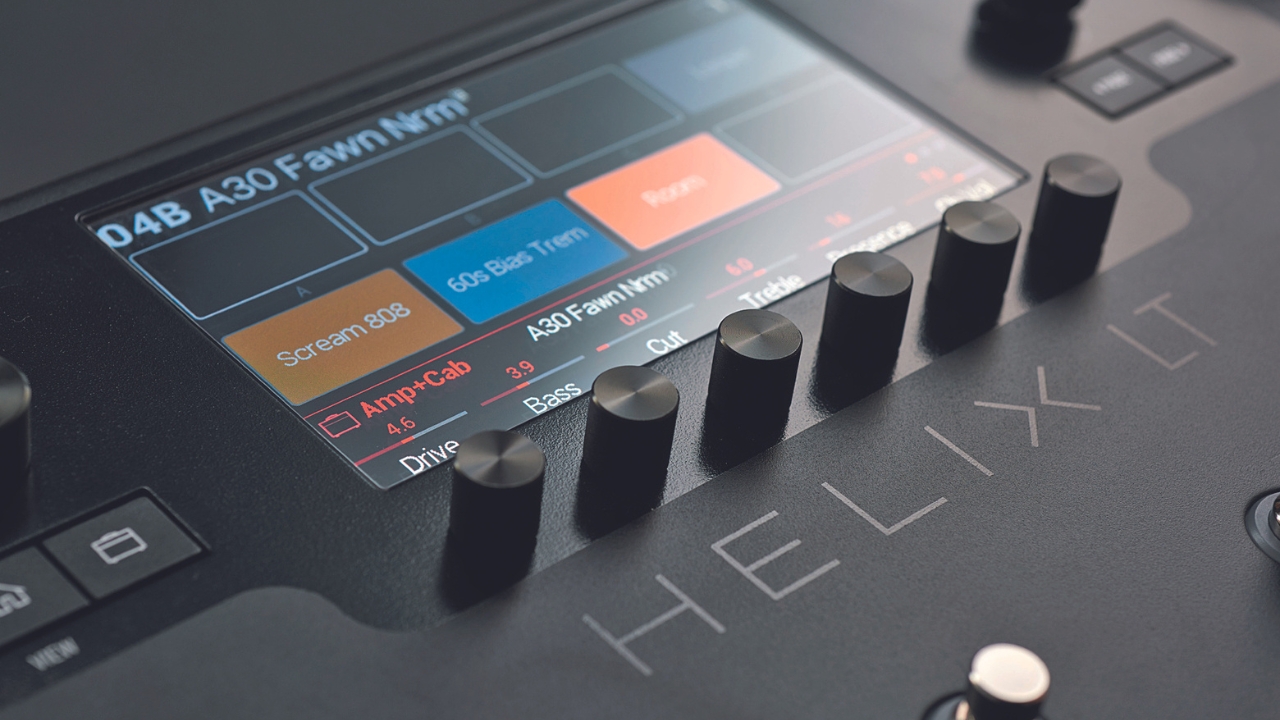
We test amp modelers in much the same way we would a regular guitar amplifer. Of course there are a lot of other options available in an amp modeler, but ultimately it's there to do the same job as your run-of-the-mill guitar amp.
The first thing we'll look at are the overall features. How many switches it has, what kind of connectivity is on offer, the amount of amp models and whether or not there are any effects pedals. We'll compare it to other offerings on the market and alongside the price, judge how it fits into the current range and whether it's better value than other offerings or not.
Next we'll get stuck into the usability of the unit. We'll try to use it without the manual, falling back on other documentation if we need but this is an important aspect as generally speaking, a guitar amp is very simple to use. Amp modelers have a lot of features but ultimately coaxing a great sound out of it should be relatively easy.
We'll test out all the switches and connection options, load up any additional software onto our PC or Mac if it has a dedicated app and ensure we explore every available option. By doing this we're looking at how the end user, and ultimately ourselves, would go about using it day to day. For the average guitarist an amp modeler needs to provide enough depth to keep you coming back, but be accessible enough that you can get it up and running with minimal Googling or watching of YouTube videos.
Finally, we'll take into account the sound. We've reviewed countless guitar amps over the years here at Guitar Player, so we're well versed in how classic amps like the Fender Twin, Vox AC30, Marcshall JCM800, and Mesa/Boogie Dual Rectifier actually sound like in the room. Many amp modelers aim to emulate these classic amps and others, so its critical to test that they hit the mark.
We'll try amp modelers through a variety of mediums too. It could be a 2x12 guitar cab, a pair of studio monitors, or just some run of the mill headphones, but ultimately we're trying to test it in the same conditions a regular musician would. We'll integrate it with regular guitar pedals too, seeing how the modeled amp reacts to feeding an analogue drive pedal into the front end.
Read more on how we test gear and services at Guitar Player.
All the latest guitar news, interviews, lessons, reviews, deals and more, direct to your inbox!
Connor is a contributor to Guitar World and MusicRadar. Having been a guitarist since the age of 10, he's played bass and guitar in bands across the South West of England. He has a background in audio engineering, having worked in some of the UK’s best studios including Rockfield and Invada, and has a passion for recording guitar. He is always keen to discover the greatest gear for capturing tone, be that microphones, audio interfaces or cab simulators.
- Ross Holder
- Matt McCrackenJunior Deals Writer
